The first board of PWC, fall 1970. Archive referance: Statsarkivet i Stavanger, Pa 1547 – Petroleum Wives Club, SAST/A-101974, U/Ua/L0003: Scrapbook, 1970-1974
Petroleum Wives Club (PWC) – Creating a meaningful and inclusive community in a foreign country
Imagine arriving in a foreign country where you do not know the language, and your husband leaves you and your children for long periods of time to go to work offshore. What kind of life would you imagine for yourself?
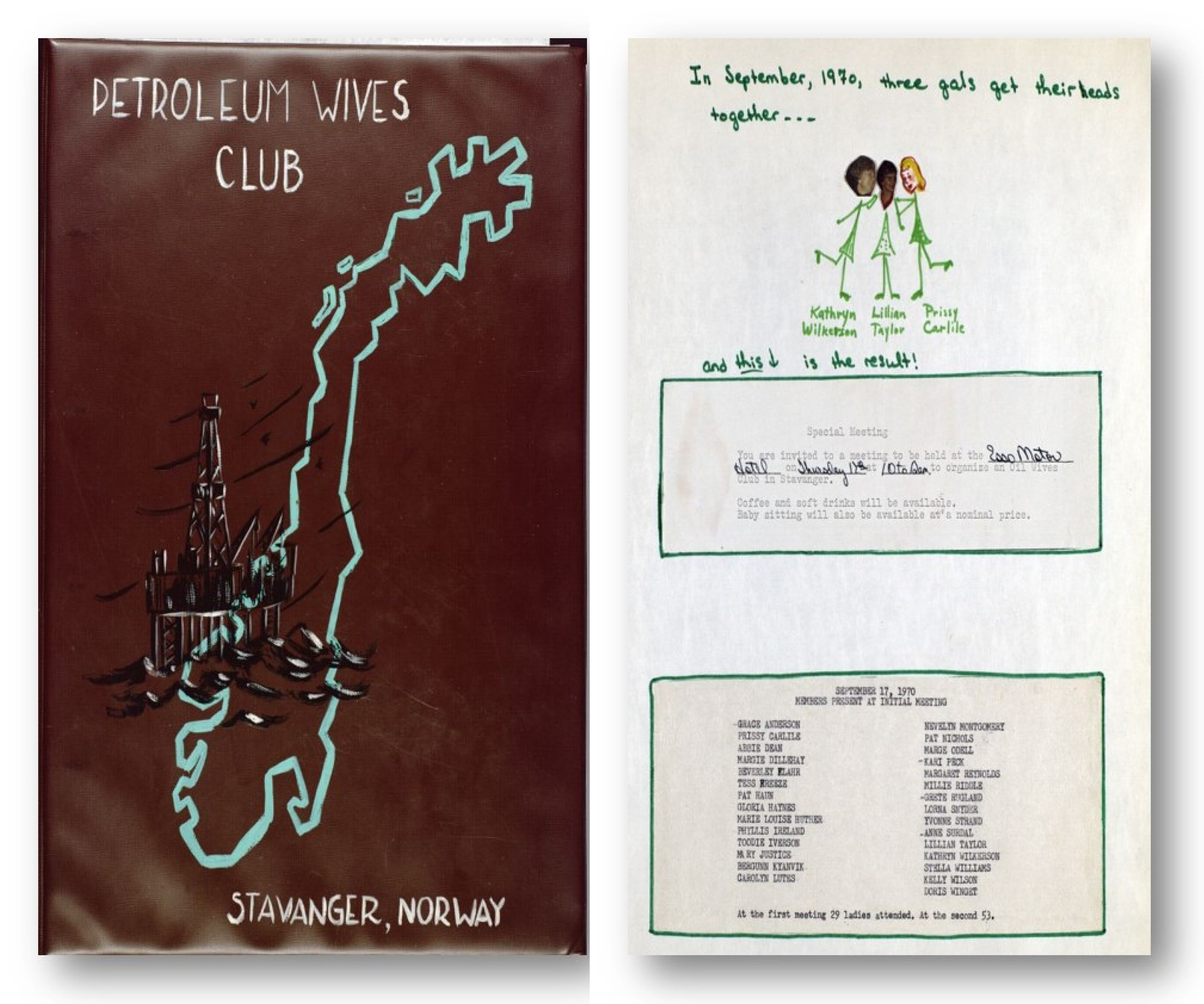
The discovery of oil in the North Sea in the 60’s led to an influx of American workers to Norway. According to the SSB (Statistisk sentralbyrå, Statistics Norway) 3681 immigrants arrived in 1971 alone. Never before or since has there been that many immigrants arriving from the USA to Norway.

The USA and Great Britain dominated the statistics on immigration in the early years of the Norwegian petroleum industry, where immigration from The USA reached a peak in the early 70s. Great Britain had equally high numbers of immigration; however, the Brits arrived in smaller numbers over longer periods. The immigrants normally stayed in Norway for about three years. There were also large numbers of immigrants from other countries, e.g. France and The Netherlands. Nevertheless, none of them reached the numbers from The USA and Great Britain. (Numbers are gathered from Statistics Norway - official statistics about Norwegian society since 1876)
They were first and foremost men, but often they arrived in Norway with wife and children in tow. Most of them settled in Stavanger, a relatively small town on the south-west coast, in what had become the oil capital of the country. The men spent their days at work, surrounded by colleagues and a work community. The wives on the other hand lacked this kind of fellowship or community. They were normally stay at home wives and mothers, which made for totally different lives and challenges than that of their working husbands.
Because their husbands were working in the Norwegian oil industry, Kathryn Wilkerson, Lillian Taylor and Prissy Carlile all lived in Stavanger in 1970. They quickly undertook the task of establishing a club for women in the same situation as themselves. There was a strong need for a fellowship and community among these women. The creation of the club provided this, as well as a growing sense of purpose and meaning for both the women and their families.
Wildcat is a name used for oil wells drilled in unchartered areas, where there is a high level of uncertainty as to what lies beneath the surface. Without explicitly mentioned in the archives, this name could very well refer to the uncertainty that the women faced in this foreign and unknown land.
Wildcats or Petroleum Wives?
The women sent out invitations for an initial meeting, and on the 17th September 1970, a meeting was held at the Esso Motor Hotel in Tjensvoll. 29 women showed up. It was at this meeting that the idea of a club was first launched and decided. Two weeks later, 53 women showed up for a second meeting. Kathryn Wilkerson was elected President, and the name of the club was to be “The Wildcats”. This name only lasted a couple of months however. At the meeting on the 18th of November in the same year, the name was changed to “The Petroleum Wives Club”.
At the meeting on the 28th October 1970, several name suggestions were discussed. Would they still be The Wildcats? Or perhaps O. W. L. s – Oil Wives League of Stavanger? N.O.W. Norwegian Oil Wives? S.O.S. – Stavanger Oil Slicks? S.O.W.S. – Stavanger Oil Wives Society? Other names were also put forward, like Oil Wives, Norway’s Oil Wives? Oil Wives of Stavanger? Petroleum Wives Club?
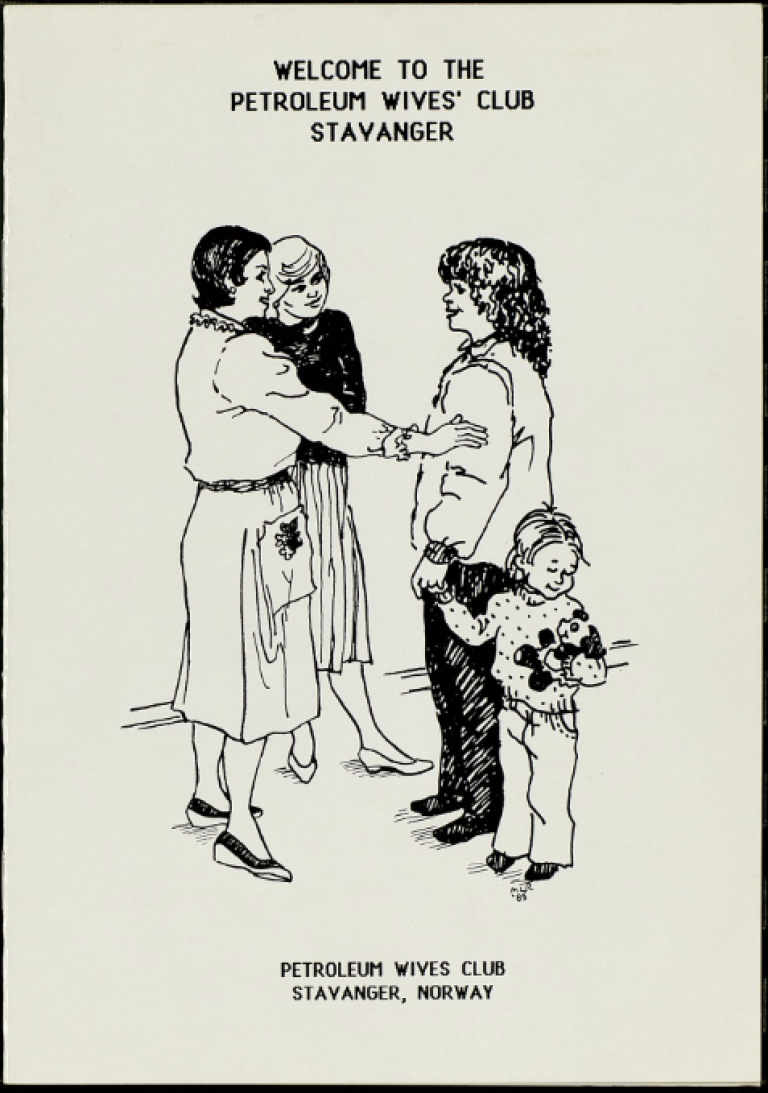
The purpose of the club – an inclusive community with room for everyone
The purpose of PWC was to help the members find their place in Norway. This was sought through new friendships and common activities between the women themselves as well as the local community. The club values of friendship and helping- hands in a cross-cultural way in turn lead to a strengthening of cultural and social integration.
The ”Good neighbour project” for instance, was one of these measures. The idea was to offer all the various members help and care during both happy and sad occasions. This would range from happy occasions like welcoming a new baby or celebrating a birthday, to sad occasions like sickness and death.
The average ”oil” immigrant family stayed in Stavanger for three years. Therefore, the club membership was always changing in composition and size. Five years after its foundation, in 1975, only 12 of the founding 53 members still lived in Stavanger.
One task for the club was to provide information about Stavanger and Norway to the newly arrived housewives. To ensure this, the club made a brochure called Stavanger Health Service Guide.
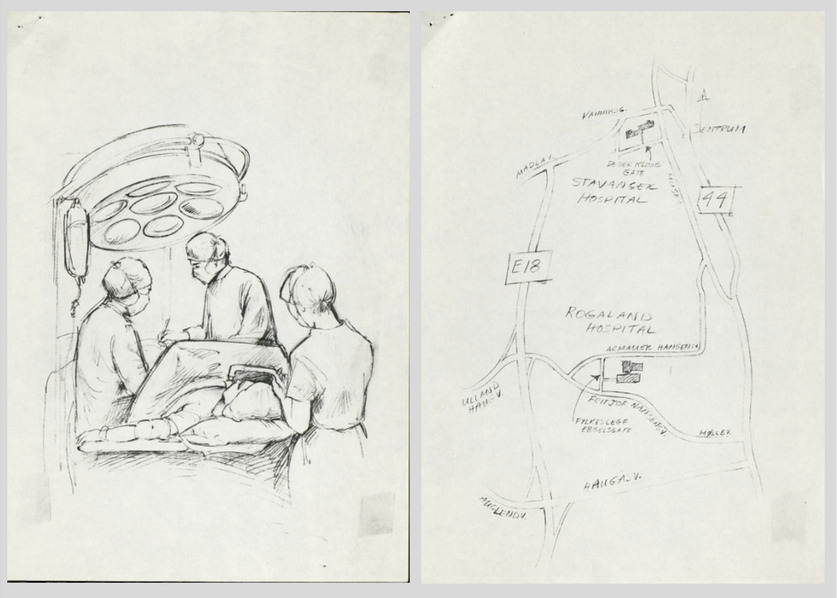
The guide contained phone numbers to the police, fire service, ambulance, A&E, hospitals, and various shelters & pharmacies. It also explained the Norwegian health system, it provided a converter for Fahrenheit and Celsius for taking temperatures, and it provided directions to the hospital, as well as floor maps over the various buildings.
Members’ Newsletter
Twice a year, the club distributed/published a newsletter to all the members called Mother’s newsletter. Here you could find information about medical services, various mother and child groups, pre-school alternatives and other activities for mothers with young children. The newsletter was meant to provide necessary information about Stavanger and the Stavanger society for English speaking parents. Often the newsletters contained short stories and articles, written by women who experienced this first hand. According to the members themselves the newsletter provided invaluable help.
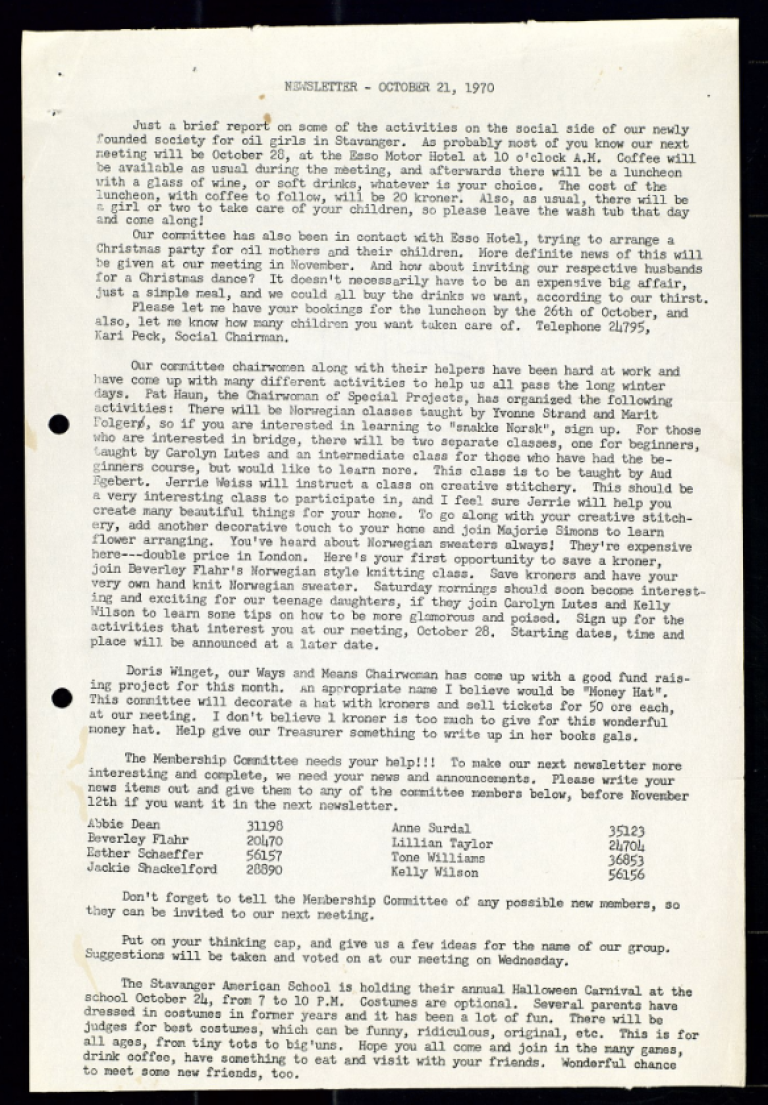
As well as the Mother’s newsletter, the club also published a monthly newsletter. The first letter was published in October 1970, and contained just a few pages. It is in this letter that the members were asked to contribute with news and announcements to make the coming letters more interesting and extensive. As time went by, and the club’s membership numbers surged, and so did the amount of pages in the newsletters. The content varies from listing the club’s activities and future events, information about the members, and information on cultural events in the Stavanger region. But you can also find phone numbers and names of available baby- sitters, as well as buy and sell listings.
Organising the club
An interesting observation while looking through the archival records is finding that in the foundation of the PWC, the women were clearly inspired by their husband's work.
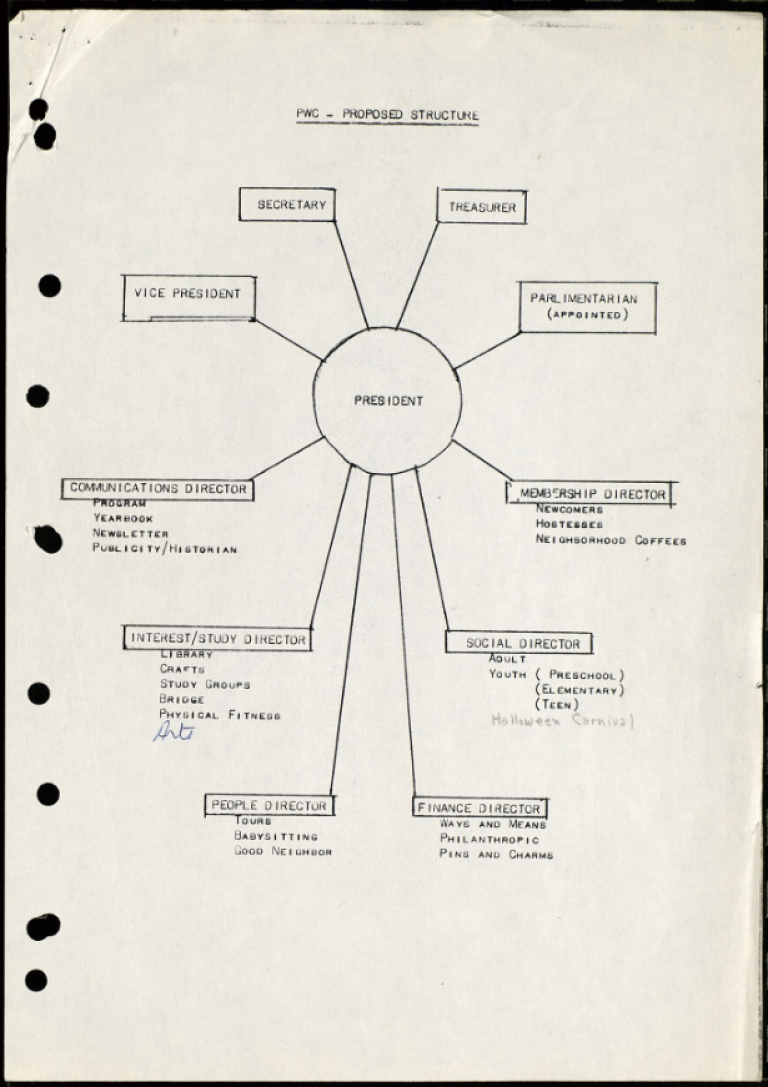
PWC - proposed structure 1975-1980. Archive reference: Statsarkivet i Stavanger, Pa 1547 – Petroleum Wives Club, SAST/A-101974, D/Da/L0001:President’s file, 1975-1980
The way the club is organised, and the roles given to the women draws inspiration from the platforms where the men worked. The women gave themselves roles and tasks in the club, similar to those found in the oil industry. Suddenly they have work outside the confines of the home, like their husbands, albeit on different terms and in different working conditions. This is evident at the inauguration on the 28th October in 1970.
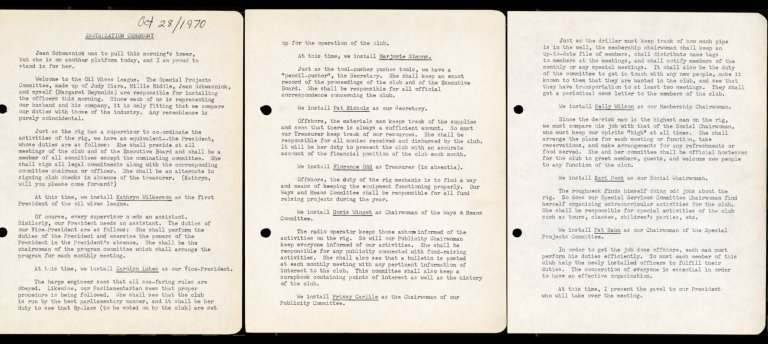
The minutes from the meeting explains that in the same way every oil installation has a Supervisor and an Assistant, so does the club with its President and Vice- President. Just like the Assistant has to step in for the Supervisor if needed, so does the Vice President for the President. Another role is that of the Barge engineer on the platforms. His task is to oversee that all legal requirements are adhered to. The club appoints a Parliamentarian to ensure that the club's procedures and rules are maintained and followed. The club's secretary is like that of the platform's tool-pusher, with both appointed to keep order. All the roles complement each other, requiring cooperation, and are essential to get the job done correctly and efficiently.
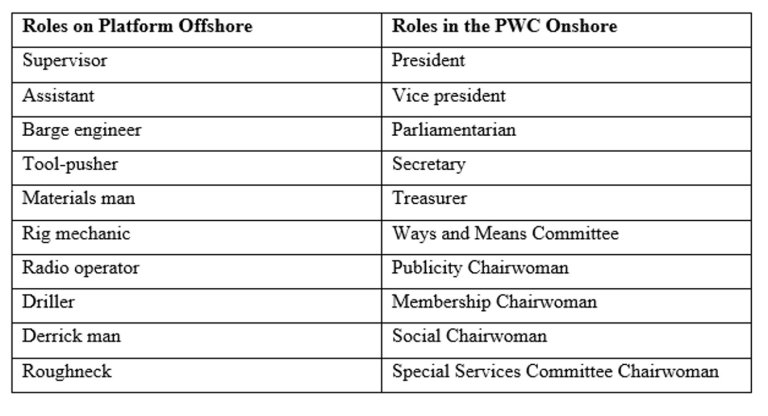
Integration through intercultural activities – “If you are interested in learning to “snakke norsk”, sign up”
A lot of the members in PWC showed a great interest for the Norwegian language, culture and traditions. Already in the autumn of 1970, the club provided courses in bridge, Norwegian and flower arrangement. Many of the members also expressed a wish to learn more about Norwegian Christmas traditions, and the Norwegian national costume traditions of “bunad”. The PWC arranged excursions to several local and regional companies and sights, like the porcelain factory at Figgjo, the leather shop Alexander in Moi, or the Iron age archaeological site at Ullandhaug.
The club was originally only open to women with husbands working in the oil industry. This changed gradually, and as the years passed by membership was opened up to all women. When the club first started to meet the meetings were held at the Esso Motor Hotel in Tjensvoll. Later the meetings would move to a location at Løkkeveien 30 in the centre of town. But it was not only in Stavanger that the “Oljekånene” or Oil-wives organised. You could find smaller similar clubs in Trondheim, Bergen and Oslo, as well as Aberdeen in Scotland.
As the number of members rose, and the number of countries represented grew, so did the numbers and variations of activities and courses.
«Norwegian style knitting», «Norwegian cooking», «Norwegian Picture Weaving,» «Norwegian History Course», «Golf Lessons», «Tennis Lessons», «Bridge», «Beginning Rosemaling», «Advanced Rosemaling», «Beginning Sewing», «Needlework», «China Painting», «Beginning Crochet», «Sculpture», «Pewter», «Ice skating», «Ibsen Study Group», «Shakespeare Study Group», «French conversation», «Spanish conversation», «German Conversation Group», «Norwegian-English Conversation Group», «Party Bridge», «Hardanger embroidery», «Dressmaking», «Oil Painting», «Bowling», «Silk painting», «Cake Decorating», «Yoga», «Ballet for children», «Flower arranging», & «Square Dance» are some examples.
Membership figures rose every year. In January 1971, the number was 69. Four years later, the numbers had risen to 376. Sixteen years after the foundation of the club, 781 members were listed. They came from all over the world and often had extensive experience with living in different countries around the world, a long way from home; Countries such as USA, Canada, Argentina, Singapore, England, Holland, Spain, Madagascar, Algeria, Ethiopia, Iran, Puerto Rico, Greece, Egypt, Nigeria, Sudan, South Africa, The Philippines, Denmark, Peru, Malaysia, Japan, Venezuela, Scotland, Bahrain, Dubai, Switzerland, Germany, Portugal, Italy, Turkey and Brazil were represented.
Halloween – a tradition from back home hardly known in Stavanger
For many years the PWC arranged a Halloween-carnival at the great hall “Kuppelhallen” at the Stavanger concert house. The event was hugely popular, especially for the many American children, who sorely missed this important tradition while living abroad.
The planning of the Halloween party the 30th October 1976 started already in May the same year. The event gathered a huge crowd of children and grown-ups alike, and there were 31 booths where they could experience things like Jail, Bingo, Spooks house, Apple Bobbing, Apron Lady, Bean Bag Throw, Bowling, Bottle Booth, Cake Walk, Can-a-Ball, Darts and Balloons, Discotheque, Fishing, Fortune Teller, Good Ship Lollipop, Country Store, Make-up artist, Mini Calk Walk, Nail Drive, Needlecraft, Oil Find, Pop Corn, Putt-putt, Ring Toss, Silhouette booth, Tricycle Race, etc.
At the Halloween-carnival of 1977 you could find Jack the Ripper, Frankenstein and his Bride Dr. Jekyll, Snakeman or Sea monster, Mummy, American Indian and Hunchback of Notre Dame in a hopsacking shirt, old boots, mask and straw palte and a Frog.
There was an entrance fee for the Halloween parties, as well as charges for food, drinks and activities. These parties were an important fund-raiser for the club, and the records show, at one point, the single biggest fundraiser for the club overall. The local newspaper normally featured an article about the party every year, in English. In 1977 however the article was written by one of the members themselves, entirely in Norwegian.
There was a school class from one of the local high schools, whom in October 1987 worked on a project called “The English speaking community in the County of Rogaland”. To do research on the project, they visited the PWC and Stavanger American School on Halloween day. Here they met Ronald Reagan on roller blades and they were offered green pineapple and pink waffles. The visit made a big impression on the Norwegian students, who later described the tradition as people dressed up in scary costumes, going trick or treat and doing nasty things like throwing toilet paper in the gardens if they do not get any sweets. As a conclusion they wished that Norway could also have a day like this!
The overriding idea of giving something back
The PWC has throughout the years sponsored various projects and taken the initiative to arrange many different activities and events. As well as the Halloween parties, the club has since the mid 70’s organised the annual Arts and Crafts Show and Sale.
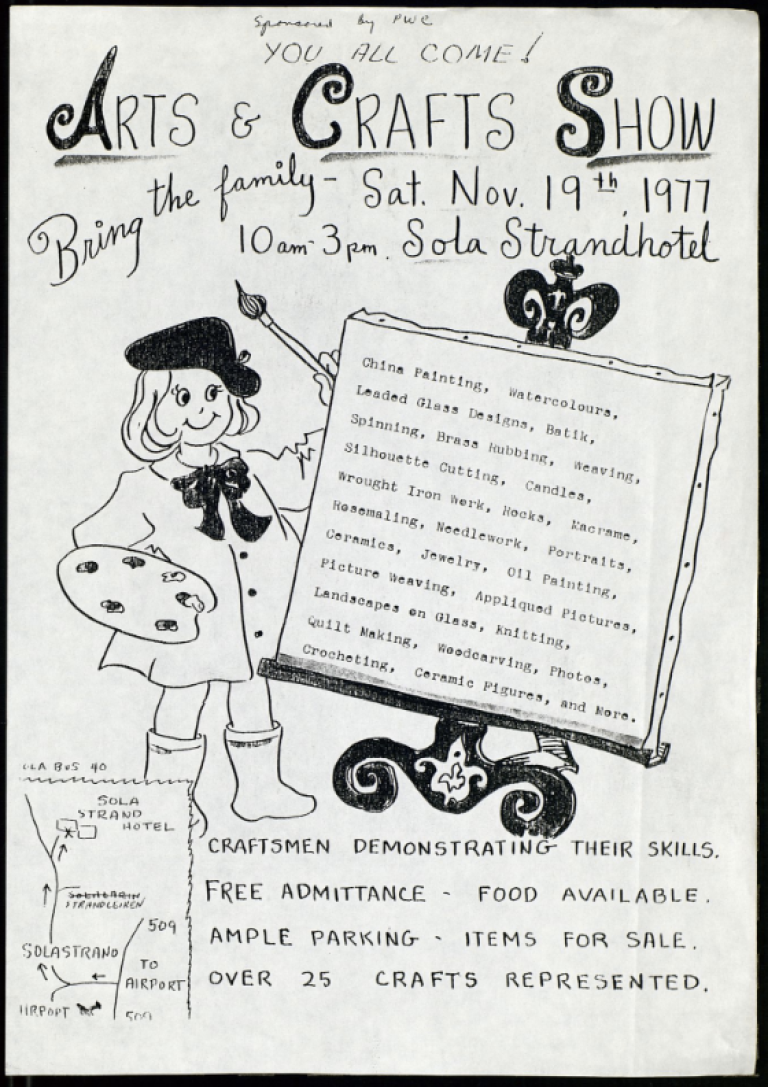
The proceeds of all these activities have provided funding for many local and regional charities, clubs and organisations, like Josefine-stiftelsen, Stavanger museum, Norsk Luftambulanse, Gjesdal Rockeklubb, Lassahagen, Stavanger sykehus, Gosen skole, speiderforeninger og Rogaland krets av Norges Husmorforbund and many more.
Recipes for a good life in Norway
In the cookbook “Takk for maten” which PWC published in the 70’s, you can find a recipe for almost everything.
Life's recipe
1 cup of good thoughts
1 cup of consideration for others
3 cups of forgiveness
1 cup of kind deeds
2 cups of sacrifice for others
2 cups of well-beaten faults
Mix these thoroughly and add tears of joy and sorrow and sympathy for others. Fold in 4 cups of prayer and faith to lighten for other ingredients and raise texture go great heights of meaningful living. After pouring all this into your daily life, bake well with heat of human kindness. Serve with a smile.
Jeannette Schneider
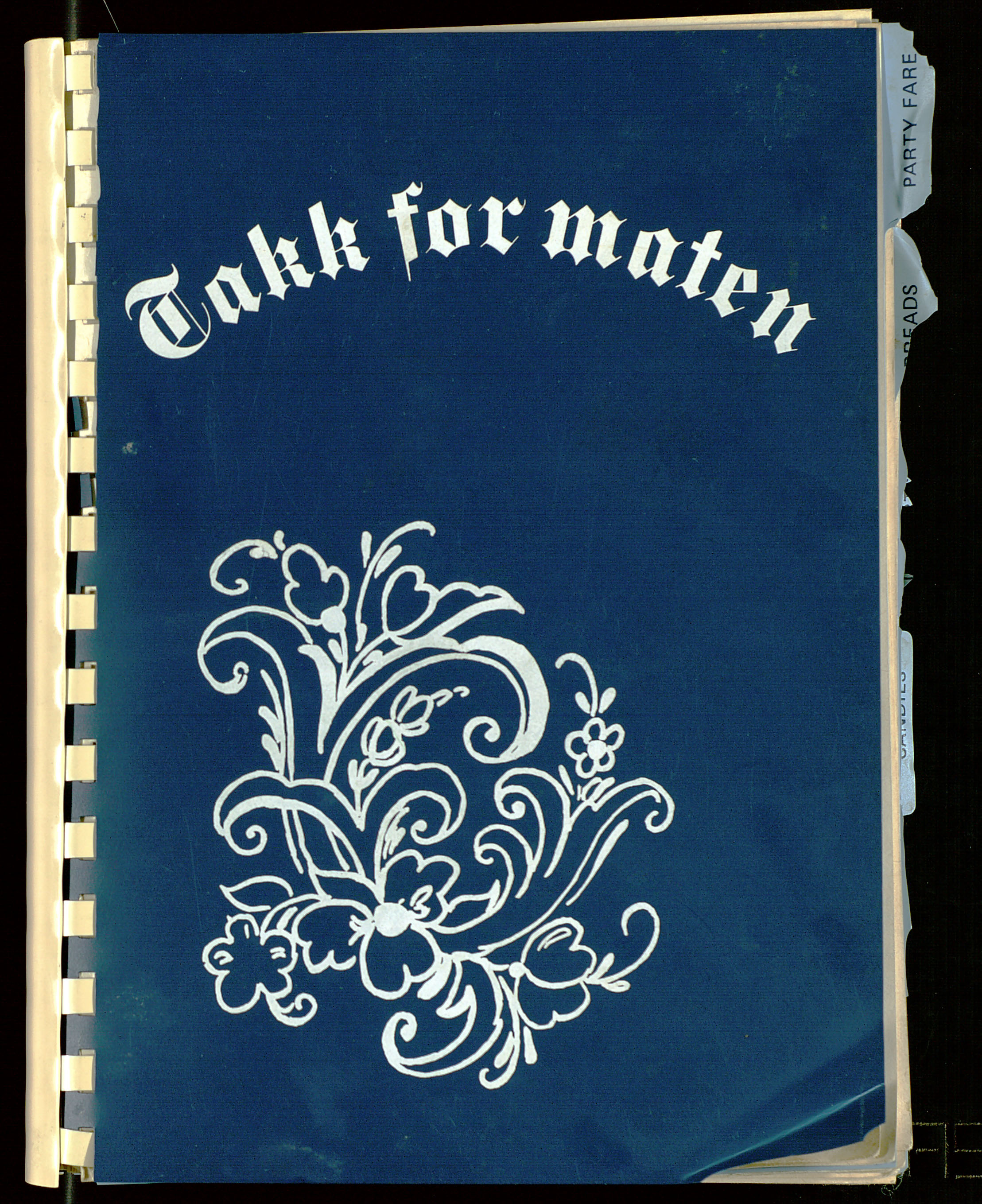
“How to cook a husband” kicks it all off, detailing in a humoristic way what to look for in a husband, and how to cook him.
Takk for maten - «How to cook a husband»
In selecting a husband, you should not be guided by the silvery apperance as in buying a mackrel, nor by the golden tint as if you wanted salmon. Do not go to the market for him as the best ones are always brought to the door. Be sure to select him yourself as tastes differ. It is far better to have none unless you patiently learn how to cook him.
The recipes collected in the book are of various international origins, often making it hard to find the correct ingredients. This was obvious in a place like Stavanger, where the local shops had a limited selection of different foods in the 70’s. Some shops however seized the opportunity, and started importing desired ingredients from abroad, to meet the wishes of the “oil wives”. If Forgotten cookies, No shortening cake, Texas Hash, Heavenly pumpkin pie, Texas millionaire pie or Impossible pie sounds tempting, download by clicking the links.
A cook book – the reason for a visit to the archives
Linda and Len Duevel made a visit to the House of Archives on Monday February 26th 2018. They told us about their combined total of 82 years as teachers and later administrators at the International School of Stavanger. They both came to Norway in the mid-1970s, Len in 1973 and Linda two years later.
The main reason for the visit was that Linda was willing to lend us her copy of the cook book from Petroleum Wives Club (PWC) so that it would be possible for us to share it with others. The conversation quickly turned to exciting recipes, food traditions and foods in Stavanger during the last 40 years. In particular she can remember how two local grocery stores grasped the opportunity when there were so many housewives wanting goods not then available in Stavanger. The stores imported stuff like pickles, spices and not to forget green jello, which was long-awaited especially at Thanksgiving. You had to ask specifically for these products, and they were handed over the counter wrapped in brown paper bags. Len recalled that in particular it was challenging to get hold of ingredients for Mexican dishes. They were not a common feature in Norwegian households in the 1970s. This is particularly amusing now given the recent New York Times commentary on the now well- established Norwegian taco-Friday.
The National Archives through the Norwegian Oil and Gas Archives are documenting the very special impact the oil and gas industry has had not merely for the Stavanger-region, but for Norway as a whole. This is not only true in relation to economics and technology, but also for the understanding of “Norwegian” culture and identity.
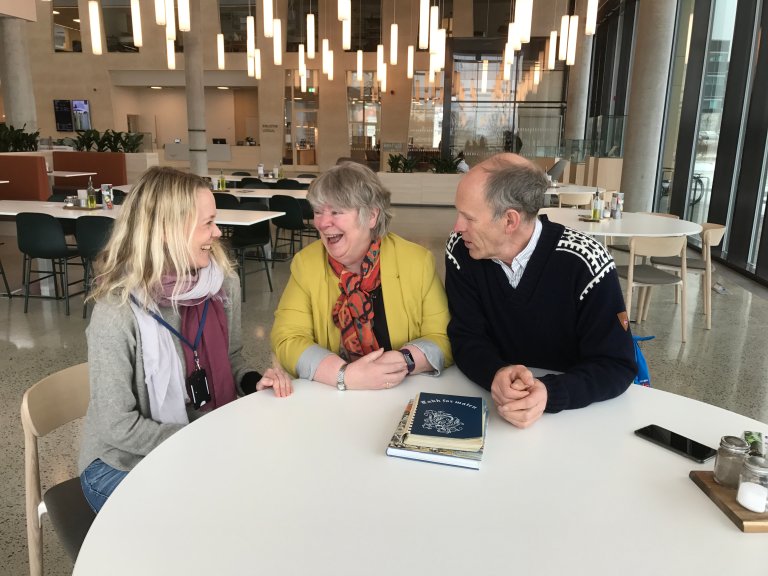
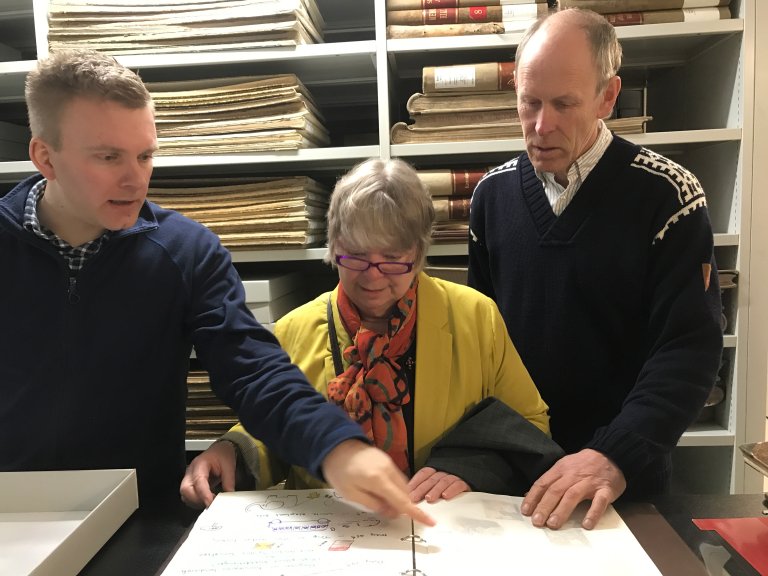
Written by
- Ine Fintland, Senior Archivist, The National Archives of Norway
- Janet Birkedal Martin, Advisor, The National Archives of Norway/The Norwegian Oil- and Gas Archives